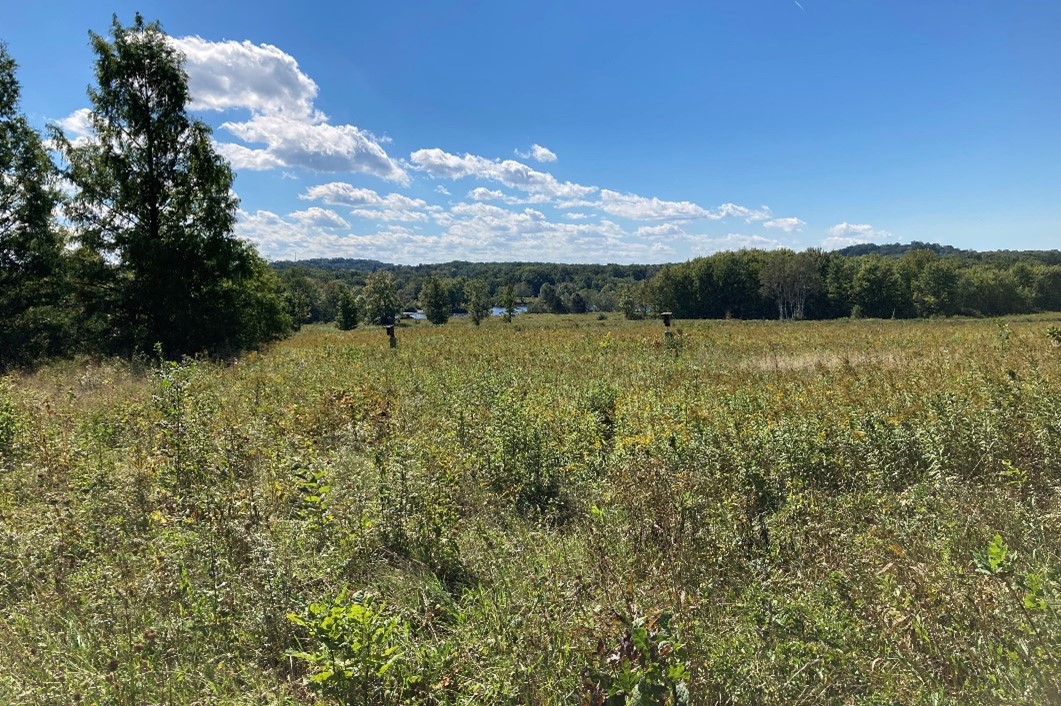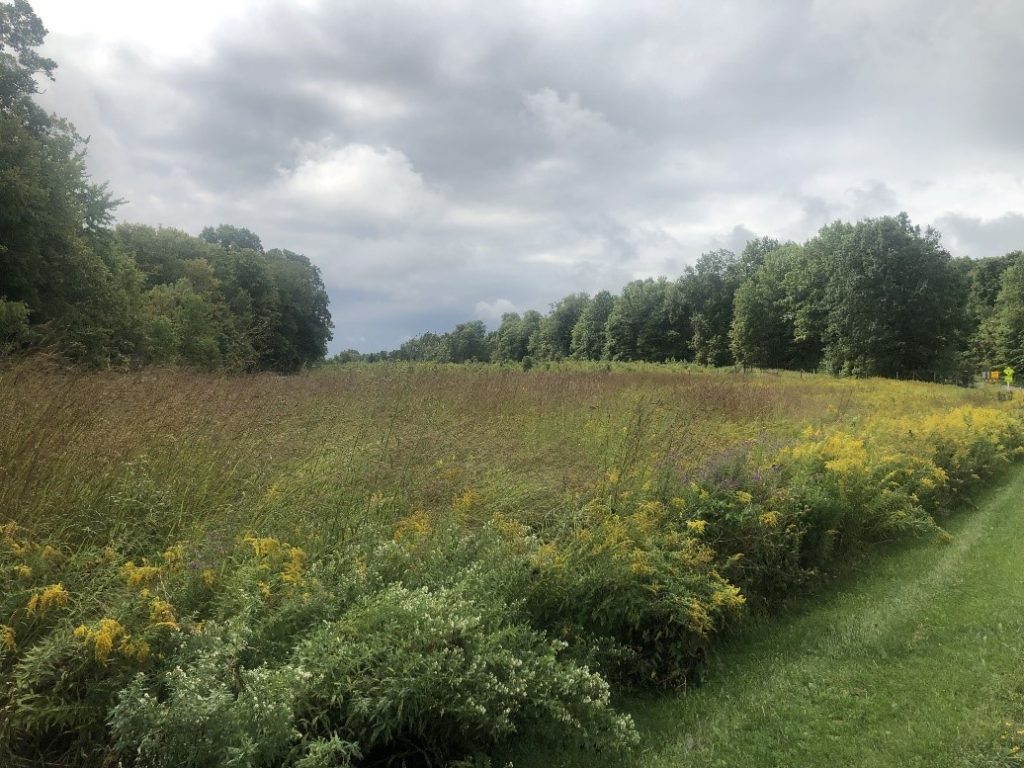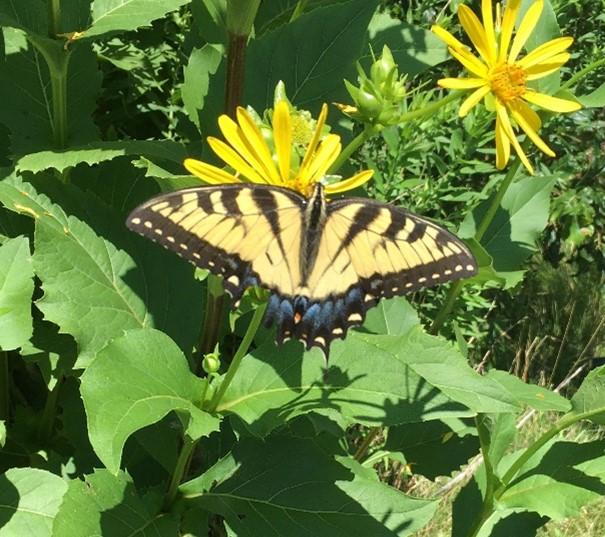Lawn Reduction Techniques with Holden Forests & Gardens

Lawns are often maintained with gas equipment and synthetic fertilizers. Four to five tons of carbon are added into the atmosphere for every ton of fertilizer produced. When it rains, fertilizers end up as runoff, polluting local waterways and the ecosystem.
Over 40 million acres in the United States are dedicated to maintaining lawns. If this land were instead used to cultivate native plants and grow the surrounding ecosystem, they would have the potential to be an enormous carbon sink. Instead, they produce and release a significant amount of nitrogen.
By transitioning lawns to native plants, you will reduce the amount of water you need for irrigation, eliminate the need for pesticides and herbicides, and save the time required for lawn maintenance and mowing, all while supporting the local ecosystem and sequestering carbon dioxide.
The Climate Toolkit interviewed David Burke, Connor Ryan and Rebecah Troutman from Holden Forests & Gardens to learn more about their replacements of lawn areas with native plants.
Why do you believe it is important to reduce mowing by replacing lawns with native plants?
Lawns do serve a purpose, but they require a lot of resources (mowing, irrigation, pest/disease control). There are two approaches to reducing the impact of lawns and improving our environment.
The first approach is to eliminate lawn entirely. This can be done in some circumstances but is often impractical, especially for homeowners. Local ordinances, or homeowners’ associations, often require certain levels of lawn maintenance. In addition, pests such as ticks live in tall grass and can pose a problem for homeowners. Eliminating lawn also eliminates potential recreation opportunities (e.g. areas for kids to play) near homes. However, when some areas of lawn can be eliminated, it offers an opportunity for biodiversity conservation. Planting former lawn in native plants offers resources for pollinators and seeds for birds and other wildlife which can expand the habitat for many animal species.
The second approach is to change the mowing frequency in lieu of a reduction in lawn area. Less frequent mowing means not running a mower every 1-2 weeks regardless of height but being more selective about mowing areas based on needs. Reduced mowing means less burning of gasoline, less noise pollution in our communities and lawns that will be more resistant to drought and pests. Frequent lawn mowing can stress grass and may result in the need for greater inputs like irrigation, fertilizer, or pesticide application. Lawns mowed less will also pick up increased diversity with other plants, such as violets or clover, that come into the mix. These other plants will offer resources for pollinators and wildlife, so reduced mowing alone can have a significant positive benefit.
“At Holden, one of our biggest reductions is in fields we manage for collections. By alternating mowing on these fields, we increase the habitat types that are present. This leads to greater diversity not just of plants but wildlife that can use these fields. Of course, this also helps us reduce mowing inputs while saving energy and time.”
Can you discuss what sparked the idea of reducing your lawn areas and tell us the process of transitioning to native plants?

Our interest was practical: we can save time and money by either converting lawn to native plants or through reduced mowing frequency. In addition, much of our interest was driven by our desire to improve the environment but this transition was also necessitated as a result of the pandemic.
For the transition of some meadows, the process has been to simply stop mowing or mow half the meadow at a time every other year to let plants come in naturally. This could require some invasive management. For some specific meadows, we are reverting to forest/edge feathering by planting native trees and shrubs. Forest/edge feathering is creating a gradual transition between two types of habitats. This more intense approach of planting and edge feathering is done on a limited basis due to budget considerations. It has been done in association with our Working Woods Learning Forest project where it serves as a demonstration site for landowners interested in learning about sustainable forest and land management.

How did you choose specific plants for the replacements and enhance biodiversity?
“In some areas, lawn was replaced by ornamental display beds, but this was limited use for us. Much of our reduction came from 1) reduced mowing of lawns or simple elimination of mowing or 2) altering our management of meadows and field to reduce mowing frequency.”
A simple example of what the average person can do is implement reduced mowing frequency. In that case, you will see an increase in plant diversity over time as other species recruit into the lawn. So, plants aren’t being intentionally planted, but natural recruitment happens. This means that biodiversity will increase where some of the plants may be natives (e.g. violets) and some may be non-native (e.g. gill over the ground, dandelions).

“In an urban setting, this isn’t terrible in my opinion, both native and non-natives can provide resources for pollinators and wildlife, especially when replacing an area that was purely grass without any floral resources.” The benefits of this approach are greater biodiversity, more resistance to drought and stress, and less inputs like fertilizer, water, and pesticides. An additional approach is buying a lawn mix from a conservation nursery that contains native plant seeds. That can speed the process of recruiting a more biodiverse lawn while avoiding bringing non-natives into the mix (although they will probably get in over time).
On a side note, at The Leach Research Station, research about lawn reduction is being done with an experimental context. Our research team is interested in studying species and planting date to see how that might affect establishment.
“For our meadows and old fields, natural recruitment will also take place with reduced mowing. For some meadows where we used edge feathering, we focused on fruit/nut bearing trees that attract birds and wildlife. Birds will then spread native seeds instead of invasive species. We also tried to consider planting trees that are predicted to be climate change resilient.”
How did you communicate these efforts to the public?
“The lawn reduction and experimental work at the Leach Station is mentioned to public groups during tours of the station. The edge feathering work taking place at Working Woods is also incorporated into public tours so that all guests will know about this technique. We have involved volunteers in the projects/plantings, and they have become advocates for what we are doing. We have written some blog posts about our research with pollinators and their contribution to plant biodiversity.”
What recommendations would you give other institutions who want to reduce their lawn area?

Start off by thinking about why you have the lawn space they have. What purpose does it serve, what inputs does it take, what message does it send, etc.? What kind of time and resources do you free up for staff if you eliminate lawn space?
You really need to take a cost and benefit approach when thinking about lawn maintenance. For organizations that have an environmental mission or are concerned about sustainability, reduced mowing or no mowing will increase biodiversity and reduce fertilizer runoff. But there are also economic benefits – reduced mowing saves money in gas, equipment and staff time.
Educating the public is also important. Some people in the general public think no-mow is messy, unkept, or lazy but when they learn the benefits it can create an understanding and potentially even inspire action for their own lawns. Even reduced mowing and a natural lawn approach (with greater plant diversity) may be frowned upon. Educating the public is done in the hopes of competing against 50 years of marketing by chemical companies that want to sell pesticides.






Recent Comments